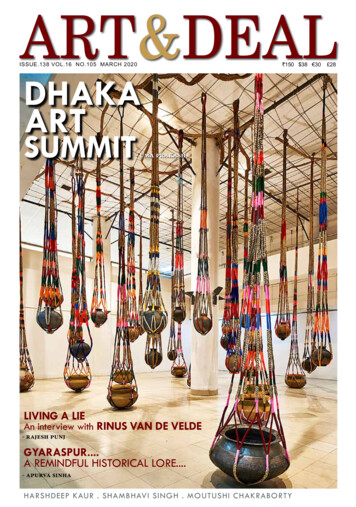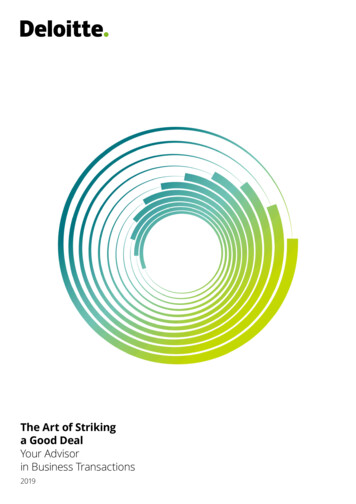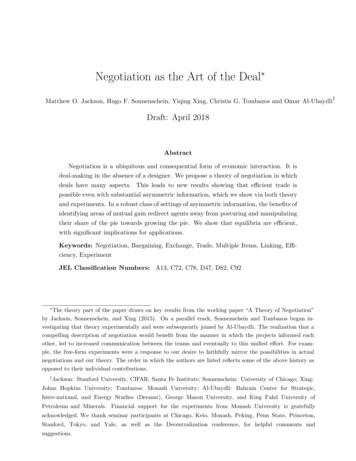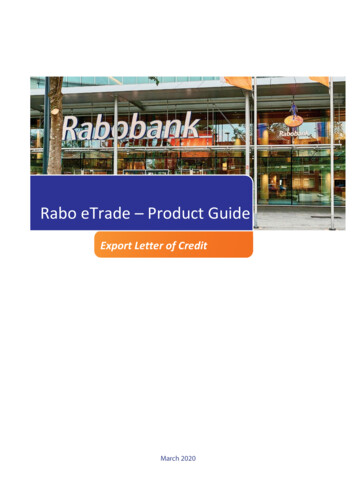
Transcription
art&dealMARCHIssue.138 Vol.16 No.105 MARCH 20202020art&deal 150 38 30DhakaArtSummitLiving a LieAn interview with Rinus Van De Velde- Rajesh PunjGyaraspur.A remindful historical lore.- Apurva SinhaHarshdeep Kaur . Shambhavi Singh . Moutushi Chakraborty01 28
MARCH2020art&deal03
MARCH2020art&deal05
MARCH2020art&dealEDITORIALDear Readers,Awaiting the change of seasons, spring breaks in as we tackle a pandemicas a community. As panic sets in with the coronavirus spreading, for thefirst time in a while we have hit the pause button on our constant hecticschedules, in these depressing times exhibitions have had to be closed forsafety. Recently, a major exhibition by Pooja Iranna took place at theBikaner House and I had the chance to catch the show this morning. Theexhibition, although phenomenal, has unfortunately been put off for nowdue to safety measures being set in place to slow down the coronavirus.In this issue, the cover story by Uma Prakash revolves around the ‘Dhaka ArtSummit 2020: Seismic Movements’, an international and non-commercialresearch platform for art and architecture, hosted every two years at theBangladesh Shilpakala Academy. Shaking our perception of the past andthe present, to create new opportunities for us to come together and make/write art history from a fresh perspective, DAS 2020 impelled by intelectualand curatorial benefaction is the epicentre of progressive upheaval of howwe absorb art. The Summit is not just an exhibition but rather a movement,focused on igniting one beyond the confines of an art exhibition. It takesus on a journey of planetary movements, geological movements, colonialmovements, independence movements, social movements as well as feministmovements.In the heart of the summit was an immersive installation “New Mutants” byAdrián Villar Rojas, where moroccon marble floor tiles are encrusted with400 million year old ammonite and orthoceras fossils. Their geographicalproximity in the Himalayas highlight the fact that these melting peaks wereonce under water.A compelling interview with artist Rinus Van De Velde by Rajesh Punjbrings out the brilliance behind his works. We peek into the artist’s mindto gain insights of his artistic process and the philosophy behind his works.Wrangling in a maze of lies, the artist plays with the viewer's mind makingthem question the “Truth”.Preeti Kathuria reviews two parallel exhibitions of legengendary artistsHaku Shah and Mahendra Raj, hosted by Kiran Nadar Museum of Art.Haku Shah’s approach pre-dates most contemporary theoretical lenses andfleeting Zeitgeist movements. Exhibiting a variety of works like paintings,terracotta sculptures, textile scrolls, journals, books and periodicals. Wefind the dramatics of everyday life represented through a rare sensitivityand naturalness in his works.Apurva Sinha explores the historic lore of “Gyaraspur”, belonging to theera of pratiharas Gyaraspur is located approximately a hundred kilometersNorth-East of Bhopal where he explores and visualizes the events andhappenings of 7th century CE.We Pray for everyone as we battle through this pandemic and hope forthings to go back to normal soon.Hope you enjoy the read.Do share with us your feedback at artanddeal@gmail.comSiddhartha Tagore&07
MARCH&P-52P-56&&&P-62PUBLISHER, PRINTER & EDITORSiddhartha TagoreCREATIVE & PRODUCTION HeadPrashanta SealCopy EditingNimrita SabharwalSUBSCRIPTION & ADVERTISEMENT 91-9899718515, 91-11- 26566898art&dealcontentINSIDEart&dealTM2020COVER STORYDhaka Art Summit – Uma Prakash.PROFILEAmid Deep Silences and Sinuous movements:The Art of Harshdeep Kaur – Professor Seema Bawa.INTERviewCONTRIBUTING EDITORSH. A Anil Kumar,Amit MukhopadhyayCORRESPONDENTSMallika Chakrawarti [Mumbai]Tanishka D’Lyma [Mumbai]Ushmita Sahu [Kolkata]Lina Vincent Sunish,Franck Barthelemy [Bangalore]Dr. Aparna Roy Baliga [Baroda]PRINTED ATCreative Offset Press,131, Patparganj Industrial Area,New Delhi-110092contributorsUma Prakash is an art writer based in Gurgan, Haryana.Seema Bawa is a professor at Delhi University. She is also an art criticand historian based in Delhi.RAJESH PUNJ is a freelance art writer and curator based in London witha special interest in Contemporary India and the Middle East.DHIRAJ SINGH is a well-known writer, TV personality and artist based inDelhi.Apurva Sinha is an archaeologist and art writer based in Bengaluru.Lina Vincent is an art historian and curator based in Goa.Preeti Kathuria is an educator, art writer and curator based in Delhi.Deadline for advertising material for allissues is 13th of every month. Unsolicitedarticles, reports and reviews cannot bereturned unless accompanied by returnpostage. Copyright of the contents ofArt&Deal is vested with the publisher/author, as the case may be. The viewsexpressed herein are not necessarily theviews of Art&Deal. RNI No. 71451/99ISSN No: 2582-0710Living a LieAn interview with Rinus Van De Velde – RAJESH PUNJ .ESSAY&Gyaraspur.A remindful historical lore.– Apurva Sinha.10202440SNIPPETS.46Film rEviewThe Dystopian Lens – Joyona Medhi.rEview [Mumbai]The Unsettling of Ordinary – Shruti Ramlingaiah.5256[DELHI]60Gendered Narratives: Belonging And The Self – Lina Vincent.62Joyona Medhi is a freelance writer and independent researcher basedin Kolkata. She co-runs a photo journalism based thematic quarterlynewspeper called Provoke Papers.Rust in The Sky – DHIRAJ SINGH.Shruti Ramlingaiah is a curator based in Mumbai.The Haku Shah Retrospective:A Curative Mist from a Hastily Combed Archive – Preeti Kathuria.64z&P-10&P-24&P-40A Monthly published every month.Issue No. 139Next issue on sale by15th April, 2020FEEDBACK, COMPLAINTS, QUERIES3-A, Ground FloorHauz Khas Village,New Delhi -110 016T : @gmail.comCover Detail: Installation view – Kamruzzaman Shadhin, ‘TheFibrous Souls’, 2018-2020, jute, cotton thread, brass, clay. Realised incollaboration with Gidree Bawlee Foundation of Arts. Commissionedand produced by Samdani Art Foundation for DAS 2020. Courtesy ofthe artist and Samdani Art Foundation. Photo Courtesy: Randhir Singh.09
COVER STORYDhaka Art Summit- Uma PrakashTMARCHBharti Kher’s large painted claysculpture Intermediaries remindsus about the multiple selves thatinhabit our very being. She believesin the transitional state and hascreated unlikely hybrids like thesehalf female forms in the process ofbecoming snakes.he fifth edition of Dhaka Art Summit featured the worksof artists from forty-four countries around the worldat the capital's Shilpakala Academy. It showcased soloart exhibitions, public art projects, curated exhibitions,seminars, symposiums and live art performances. Dhaka Art Summithas become an important event in the contemporary art circuit,and has created a platform that explores ideas and histories outsidewestern narratives and challenges colonial frameworks. Furthermoreit welcomes middle-income countries in Asia, Africa, Latin Americaand the Caribbean.The title “Seismic Movements” for the latest Summit is drawn fromart historian Zahia Rahmani’s “The Seismography of Struggles,”It was an inventory of non-European critical and cultural journalsproduced between the end of the 18th century and 1989. The seismicmovement, are the waves of energy that creates ripples across the earthwhen an earthquake strikes. The summit curated by Diana CampbellBetancourt, invites artists to examine artistic, social and politicalcolonial movements that have affected the world.Two artists whose works relate directly to the theme are Adrian Villar Héctor Zamora, ‘Movimientos Emisores de Existencia(Existence-emitting Movements)’, 2019-2020. Performativeaction with women and terracotta vessels, Courtesy of the artistand Labor. Photo: Randhir Singh Installation view – Bharti Kher, 'Intermediaries', 2019-2020,commissioned and produced by Samdani Art Foundation forDAS 2020. Courtesy of the artist, Samdani Art Foundation, andNature Morte, realised with additional support from NatureMorte and Perrotin. Photo Courtesy: Randhir Singh.2020art&dealRojas and Damien Ortega. Adrian’s The Theatreof Disappearance is an immersive installation thatthe visitor walks on when entering the Summit. Itis created over a marble floor encrusted with fourhundred million year old ammonite and orthocerasfossils. It shows both organic and inorganic materialsthat underwent change over for 300 million years,tracing the seismic shift that occurred in the evolutionof humanity and our planet.The other installation Damien Ortega’s Sisters;Hermanas is located in the open. Here in an empty,uninhabited lot covered by wild weeds and grass, abig conical figure is raised. It is made of red bricksand can be described either as a stupa, or a preColombian pyramid. It is a sculptural silo, containingan offering with a sample of one of the native cornsof Mexico, a single seed. Damián Ortega explains “Adiverse ecosystem working in solidarity to producecorn, beans, squash and chilli. This ecosystem, to acertain point is what has fed us. I could even say thatit is the best we have as a country, that's why I wantto share it. Limitations of private property are testedwhen rituals, knowledge and products are taken fromone place to another”.Artists created works under several themes such asgeological, colonial, independence, collective andspatial movements. There were several artist-basedorganizations like Drik, Pathshala, Chobi Mela,Britto Arts Trust, RAW Material Company, Hong011
COVER STORYMARCHKong Artist’s Union and others that contributedgreatly to the success of the Summit.Colonialism is naked capitalism under the guiseof religion and development aid that controll hugeportions of the world. Certain artists bring to lifethe narrative of suppressed people from all over theworld in their art. There appears to be a similarityin the tales of the slaves of America and the poorworkers in Asia.Adebunmi Gbadebo’s True Blues: 18th Hole edition IIIconsists of a large network installation of handmadepapers in the color blue that explore themes of land,memory, and erasure. “In this series, I use humanblack hair sourced from barbershops, cotton, indigo,denim, “Indigo Blue” hair dye, and rice paper as away of processing the transformation of the landfrom a plantation to an exclusive golf club. Theimages embedded in the sheets are silk-screens onrice paper of the architectural drawings convertingthe land into a golf course. I also printed a page ofthe will of the slave owner of True Blue Plantation Installation view – Adrián Villar Rojas, ‘New Mutants’, 20172020, Moroccan marble floor tiles encrusted with Devonianperiod micro Ammonite and Goniatites fossils; blue chroma keypaint, plant-based pigments (indigo, sindoor, alta), gouache; sand;and coal, on aggregate rammed earth walls. Commissioned andproduced by Samdani Art Foundation for DAS 2020. Courtesy ofthe artist, Samdani Art Foundation, Marian Goodman Galleryand kurimanzutto. Photo Courtesy: Randhir Singh. Installation view – Marlon de Azambuja, ‘Untitled (from theBrutalismo Series),’ 2019-2020, industrial metal clamps, buildingmaterial sourced in Dhaka. Commissioned for DAS 2020.Courtesy of the artist and Samdani Art Foundation and Institutode Vision. Realised with additional support from Acción CulturalEspañola (AC/E). Photo Courtesy: Randhir Singh.2020art&dealfrom the 1700s listing his human “property” by theirname, age, duties, and value that was 2000 USD perperson,” said the artist.and he converted handmade paper into scarred,blistered, pierced and wounded surfaces, evokingmemories of human skin in the aftermath of trauma.Candice Lin shows another instance of dislocation.She refers to the horrors of life in the Caribbeanfor Asian and African workers brought from theiroriginal homes to grow commodities for imperialconsumption. A tapestry where a man is ravaged bysnarling beasts in Papaver Somniferum says it all.The Summit was a tribute to the artists, architectsand thinkers who have shaped Bangladesh. Mostnoteworthy was Muzharul Islam, who created alanguage of architectural modernism in South Asia.Cultural, social, political pressures as well as personalexperiences played crucial roles in executing hisworks.Furthermore the Faiham Ebna Sharif shows the plightof Baganiya communities who moved as indenturedlabourers for the tea gardens in Sylhet, only tobecome citizens of Bangladesh, and completelylose touch with their ancestors. In Cha Chakra: TeaTales of Bangladesh the artist employs old printedmaterials, advertisements, historical documents toshow the inequality and exploitation. Internationallyacclaimed Bangladesh artist Mahbubur Rahman’stwo channel video Transformation was created fromhis performance with Bangladesh’s indigo workers,Bihari migrant rickshaw pullers in Kolkata, and horseriders in the bank of the Padma River in Bangladesh,linking the two countries.Somnath Hore’s Wound Series echoes the famineof 1943, the communal riots of 1946, and thedevastations of war. “All the wounds and woundedI have seen are engraved in my consciousness.” theartist reflects. The impact of the scarred tree, a manknifed for no particular reason impacted him deeply,Several artists have created works to align with hisphilosophy like Rana Begum, Shezad Dawood andDayanita Singh and others. Rana Begum has createdan installation on the central staircase of ShilpakalaAcademy, the venue of the Dhaka Art Summit.It consists of handprints on the winding wall,endorsing what hands can achieve together. They arethe fingerprints of Bangladeshi collaborators of thesummit from the beginning to present day. There aresimilar traces on the terracotta screens and bricksof Muzharul Islam’s art school Charukala, now thefaculty of fine art university of Dhaka.“It was great to participate in this year's DAS, andas usual Diana Campbell Betancourt has out doneherself ! The energy and ambition was incredible. Itwas wonderful to create something that really drawson my experience in Bangladesh and reconnects meto the people and community in a way that I don'thave anywhere else,” was what Rana Begum said013
COVER STORYMARCH2020art&dealaudiences. Singh is against the elitist attitude ofexclusiveness of the museum and feels it should beopen to all. She has created moveable museums withher photographs, of interiors and spaces that unfoldstories that are easily accessible.Social Movements and Feminist Futures address theunfairness in this world when it comes to protectingthe human rights of the citizens. People of color,indigenous people of diverse sexual and genderorientation become easy victims. Artists like BhartiKher, Nilima Sheikh, Hector Zamora, Saskia Pintelonand others have addressed them in their works.Nilima Sheikh’s new work onKashmir, “Beyond Loss (2019–2020)” takes the form of narrativescrolls that show different aspectsof mourning, while endorsing thecourage of the women of Kashmirin the face of an oppressive worldoutside. She shows the starkrealities with a lack of pretensionin the narrative.Nilima Sheikh’s new work on Kashmir, “Beyond Loss(2019–2020)” takes the form of narrative scrolls thatshow different aspects of mourning, while endorsingthe courage of the women of Kashmir in the face ofan oppressive world outside. She shows the starkrealities with a lack of pretension in the narrative.Hector Zamora’s Movemnetos Emisores de Existenciais an installation made from hundreds of raw clayvessels, in different shapes and sizes, akin to theceramic traditions of Bangladesh and Mexico.Instead of the traditional vessels of food and watercarried by the women on the head, the artist laysthem on the ground, liberating the women. Duringthe performance a group of women walk directly onthe installation, breaking the vessels, as a revolt fromthe human bondage of the past.Saskia Pintelon’s No News is Good News rearranges text inEnglish, Flemish and Sinhalese to create her own visuallanguage in a positive vein. She defies the old rules ofbeauty, success and happiness for women and creates herown subjects ranging from romance, gender and love.about her participation in the Dhaka Art Summit.Shezad Dawood also gets his inspiration from thelegacy of Islam as he creates an adaptable stageset. Tapestry takes the form of rooms. There areseveral woven screens with abstract images greetingthe viewer. As you go past them and turn aroundanother a set of tapestry with Mughal designsbeholds you. He has created them by collating andsewing different textiles sometimes incorporatingthe Kantha techniques. The artist allows the viewerto interact with his work. He wanted to create “Abuilding like a garden, with bricks as tapestry andwith a sensitivity that is not western, but brings alivethe Mughal architecture”, said the artist.Dayanita’s Museum of Shedding is like MuzharulIslam’s open structured frameworks, open to multiple Installation view – Kamruzzaman Shadhin, ‘The FibrousSouls’, 2018-2020, jute, cotton thread, brass, clay. Realisedin collaboration with Gidree Bawlee Foundation of Arts.Commissioned and produced by Samdani Art Foundation forDAS 2020. Courtesy of the artist and Samdani Art Foundation.Photo Courtesy: Randhir Singh. Installation view – Nilima Sheikh, ‘Beyond Loss’, 2019-2020,Casein tempera and canvas scroll. Commissioned for DAS 2020.Courtesy of the artist and Chemould Prescott Road.Photo Courtesy: Randhir Singh.015
COVER STORYBharti Kher’s large painted clay sculptureIntermediaries reminds us about the multiple selvesthat inhabit our very being. She believes in thetransitional state and has created unlikely hybrids likethese half female forms in the process of becomingsnakes.Several artists recorded the spirit of resistance andstruggle for freedom when Bangladesh fought forits independence. Rashid Talukdar's Arms Drillby Women Members of the chatro Union (studentsunion) 1st March 1971 and other photographsendorse the liberation war that took place whenWest Pakistan refused to hand over power to SheikhMujibir Rahman in 1971, despite getting majority ofthe democratic votes in Pakistan. Rahman took overthe cause of creating an independent nation. Thisinspiring image of empowered women marchinggreeted the visitors at the entrance of the Summit;revealing their sense of pride for the nation.Maryam Jafri’s Independence Day 1934-75 workpresents over sixty images culled from the firstIndependence Day ceremonies of various Asian,Middle Easten and African nations. On view arerelevant documents, VIP parades, the stadium saluteand the first address to the nation organised by theoutgoing colonial powers.MARCHCollective movements were obvious in OlafurEliasson’s Your Uncertain Shadows. Can art changeyour perception? The artist Olafur Eliasson’s YourUncertain Shadows definitely tries. First, severalspotlights project light on a white wall, as the visitorsenter, their presence fills the void of the room withtheir shadows. The moving shadows rise above race,religion, age and class, showing the sameness theypossess. He urges the visitors to realize this andengage with all those around. This art piece lingersin the mind's eye.Geological Movements saw Karan Shrestha's threechannel video installation. It was accompanied bya large ink drawing. There are several layers in thiswork. The central video shows natural disasters,political instability, revolutionary upheaval, andstate-sponsored violence in Nepal. The other twovideos show traditional practices that deal withcontemporary violence like pig sacrifices andBudhists performing chhakk (prostration)Art educator Biswajit Goswami curated the exhibitiontitled Roots .It is a tribute to artists and art educatorslike Zainul Abedin, S M Sultan, and Safiuddin Ahmed.They were pioneers who, through their teachings andworks, influenced the artists of Bangladesh to shedtheir colonial phobia and create their own identity.2020art&dealThey show a wide range from paintings, print makingto sculptures. Zainul Abedin, set up the Faculty ofFine Art in Bangladesh. Famine is a part of the seriesof sketches on the man-made famine that had spreadthroughout Bengal. He also realized the significanceof folk art and upheld their traditions.SM Sultan’s painting of the farmers made withnatural pigments on un-primed jute canvases, revealthe strength of Bengali peasants, in their struggleagainst colonial and ecological disasters as seen inFirst Plantation Sketch. Installation view – Huma Bhabha ‘Cowboys and Angels’, 2018,Cork, styrofoam, acrylic paint, oil stick; and ‘Untitled’, 2014, inkand collage on colour photograph. Both courtesy of the artist andSamdani Art Foundation. Photo: Randhir Singh.Photo Courtesy: Randhir Singh. Installation view – Chitra Ganesh, ‘Sultana’s Dream’, 2018,portfolio of 27 linocuts BFK Rives Tan; and ‘Totem’, 2018/2020,brick, bamboo, clay, mud and straw, Commissioned and producedby Samdani Art Foundation for DAS 2020. Both courtesy of theartist and Samdani Art Foundation.Photo Courtesy: Randhir Singh.Safiuddin Ahmed was known for his contribution toprintmaking in Bangladesh. He began by focusingon Adivasi women but moved on to abstract art as isevident in The Angry Fish Jamal Ahmed’s work Batherreveals a two-dimensional painted figure againstpastoral and urban scenes. The drama and tensionhe evokes in his textured work makes them unique.The delicacy in this work reinforces the physical andcultural landscapes of Bangladesh.There were other jewels like Otobong Nkanga,Landversation, Korakrit Arunanondchai’s NagaYasmin and Otolith’s Group’s O Horizon.Otobong Nkanga, ‘Landversation’, (2016, Beirut,017
COVER STORYLebanon) was a site-specific installation withvarious materials in variable dimensions. ThroughOtobong Nkanga’s month-long residency in Dhaka,she interrogated “the complex relationship betweenthe human subject and land, dealing with thecontradictory ways in which we inhabit the worldand are dependent on it.”Korakrit Arunanondchai’s huge sculpture of a Naga(a reincarnating deity found across the mythology ofSouth and Southeast Asia that shifts between snakeand human form) transformed into a stage for theartist’s newest performance work in collaboration withAlex Gvojic that connects the river-based histories ofBangladesh and Thailand. Arunanondchai recreatesthe concept of Ghost Cinema, a post-Vietnam Warritual in Thailand. It was felt that during the outdoorscreening functions there was communicationbetween the audience and the spirits. When theAmerican soldiers stationed in Thailand screenedfilms in the forests, the locals attributed them toghosts, lost in their folklore and rituals.The philosophy of self-belief expounded by poetRabindranath Tagore was omnipresent at the Summitespecially in Otolith Group’s (founded by KodwoEshun and Anjalika Sagar) latest video, O Horizon,2018. This video comes out of a long-standingresearch interest in Rabindranath Tagore and hisfounding of Visva-Bharati, a school in Santiniketan,West Bengal, India, that served as a living laboratoryMARCHin art, life and craft. Tagore was a highly prolific poet,philosopher, writer, and educator who wrote novels,essays, plays, and poetic works in colloquial Bengali.He was a key figure of the Bengal Renaissance, acultural nationalist movement.“It was a rewarding experienceto welcome nearly 75,000 peopleover the first two days of DAS toexperience a sense of togethernesswoven together by art, artistsand their ideas. We find commonground with the rest of the globalmajority world from Bangladesh,and work together to shake upwestern centric art histories”, saidDiana Campbell Betancourt, chiefcurator of Dhaka Art Summit. Installation view – Clarissa Tossin, ‘A Queda do Céu (TheFalling Sky)’, 2019, laminated archival inkjet prints and wood.Commissioned and produced by Samdani Art Foundation forDAS 2020. Courtesy of the artist, Commonwealth and Council,and Samdani Art Foundation. Photo Courtesy: Randhir Singh.Dhaka Art Summit is run by Samdani Art Foundation,a private art trust created in 2011 by art collectorcouple Nadia and Rajeeb Samdani. They haveworked tirelessly to put Bangladesh artists on theinternational art map. This year the Samdani awardwent to Soma Surovi Jannat whose installation Intothe Yarn, Out in the One, in wood pen and wall. Shehas drawn several stories along the walls and on thewooden spirals she has created. “My work is inspiredby nature, particularly the spirals of the milky way,”said the artist.Bangladesh was celebrating the founding fatherSheikh Mujibir Rehman’s 100 years birth. His imageappeared in all the billboards in neon lights andposters in Dhaka city.The Summit has taken the celebration to a higherlevel. An impressively large exhibition titledLighting the Fire of Freedom pays a tribute to him.The intimate details followed the chronologicaljourney through his life and the way he addressedthe challenges, are on display. Through archivaland contemporary materials including personalphotographs, newspapers, videos and works of art,2020art&dealthe exhibition showed the love and reverence heenjoys in his country. The exhibits marked the timeof the Bengal Presidency under the British rule, toEast Pakistan and finally Bangladesh’s challengesduring the partition in 1947, the famous Languagemovement in 1950 and finally the battle for country’sindependence in 1971. The exhibition paid a fittingtribute to Bangabandhu as Sheikh Mujibir Rehman isaffectionately called.“It was a rewarding experience to welcome nearly75,000 people over the first two days of DAS toexperience a sense of togetherness woven togetherby art, artists and their ideas. We find commonground with the rest of the global majority worldfrom Bangladesh, and work together to shake upwestern centric art histories”, said Diana CampbellBetancourt, chief curator of Dhaka Art Summit. Installation view – Right: Yasmin Jahan Nupur, ‘Let Me GetYou a Nice Cup of Tea’, 2019–20, antique furniture, antique teaset, embroidered textiles, tea, performance. Commissioned forDAS 2020. Courtesy of the artist and Exhibit320, with supportfrom the Peabody Essex Museum, Salem. Left: Elia Nurvista,‘Sugar Zucker’, 2016-2020, crystallised sugar, mural. Courtesy ofthe artist019
profileMARCH2020art&dealAmid Deep Silences andSinuous movements:The Art ofHarshdeep Kaur- Professor Seema BawaThe delineation of figures,portraits and landscapesmay appear different, but forHarshdeep all forms derivefrom the same creativeprocess. A process that doesnot distinguish between whatmanifests on the outside andthe interiority of the subject,rather she sees all forms asemerging from a commoncreative matrix and wherethe depth is in the surfaceitself.Harshdeep Kaur’s recent body of work is refreshinglybold and honest in its essence, going back to thefundamentals of art, she delves into figurative andlandscape paintings. A rare attention to the craft ofimage-creation tries to not look just for the inner meaning butalso the outer manifestation of the object/subject of the painting.This semiotic synchronicity between layers within the imageis significant not just for viewing the work but furthermore toexperience it.Perhaps her most experiential works are the ones derived fromSikh heritage, with its distinct cultural and visual world that isboth a spectacle and a lived creed. She avers “Sikh people andrituals inspire me to create a new dimension in Sikh art. TheKhalsas wearing kesari turbans; engaged in meditation, workingthe fields or horse riding soldiers, skilled in warfare have left alasting impression on my art and me”.The distinct sect of the Nihanga warriors within the Sikhcommunity are trained in five weapons, the pancha shastrawhich is also symbolically represented on their steel reinforcedtall turbans, the dastar bunga. They are usually clad in electricblue chogas and it is believed that Guru Gobind Singh ji himselfinitiated the Nihangas. Seen in their full glory annually at HollaMohalla at Anandpur Sahib, Nihang Singh’s practice gatka andother equestrian and martial arts all through the year. Harshdeepcaptures the arresting spectacle embedded in this performancefull of military regalia of the Sikh warrior astride the horse infull gallop as well as the seamless relationship between the manand horse, in service of the creed they serve together.Movement of the body, its flexibility and ability to suggest notjust flexion but also emotions in ballet, have inspired manyartists, like Edgar Degas who engaged with dancers and theirpractice deeply and familiarly. Harshdeep has worked with thefigures of ballerinas who she studied while her daughter waslearning ballet. Unlike the frenetic action of the Nihangs, hereshe dwells on the graceful and expressive curves of the dancers. Harshdeep Kaur,The Saint on the Horse back,Acrylic paint, ink and charcoal on canvas,60 x 36 inchesThe attire of the Sikh men and women not only proclaims theircommitment to the faith but also reinforces their individualand communitarian identity. The turbaned man, distributingprashad to the many upraised hands, the utter quietude in whichan elderly person reads the gutka or the holy word. The artist hasexplored the turban, especially the Dumala or
MARCH 2020 art&deal 09 z contributors INSIDE & CORRESPONDENTS content & P-10 & P-24 & P-40 UmA PRAkAsh is an art writer based in Gurgan, Haryana. sEEmA BAwA is a professor at Delhi University.She is also an art critic and historian based in Delhi. RAJEsh PUNJ is a freelance art writer and curator based in London with a special interest in Contemporary India and the Middle East.










